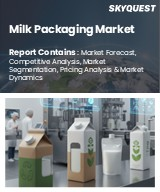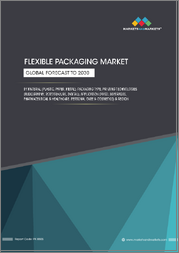
|
시장보고서
상품코드
1557304
연포장 시장 : 예측(2024-2029년)Flexible Packaging Market - Forecasts from 2024 to 2029 |
||||||
연포장 시장은 CAGR 4.10%로 성장하며, 2024년 시장 규모 2,334억 2,400만 달러에서 2029년에는 2,875억 6,000만 달러에 달할 것으로 예측됩니다.
구조를 쉽게 변경할 수 있는 포장 상자나 요소는 연포장으로 간주됩니다. 소비자 및 산업 부문에서 시장 제품을 보호하고 다양한 품목을 유통하기 위해 사용됩니다. 가벼운 가방이나 파우치는 열이나 압력을 사용하여 밀봉됩니다. 연포장은 일반적으로 식품의 보존성을 높이거나 고품질 그래픽과 같은 다른 마케팅 동향을 충족시키기 위해 사용됩니다.
쓰레기장에 쌓이는 폐기 식품을 줄이는 중요한 요인은 품질이 좋지 않은 식료품의 수명을 연장하는 것입니다. 일단 곰팡이가 침입하거나 습기가 차면 인간의 소비에 적합하지 않을 뿐만 아니라 시장 가치도 잃게 됩니다. 포장에 사용되는 재료의 유형, 환경 조건, 산소, 빛, 습기, 미생물 등 요소와의 상호 작용 정도 등 다양한 요인이 식품의 수명을 결정합니다.
연포장용 플라스틱 필름은 우수한 차단성이 특징입니다. 높은 차단성으로 섬세한 식품을 습기, 빛, 산소로부터 효과적으로 보호할 수 있습니다. 또한 연포장재는 봉지나 파우치를 밀봉하는 데 사용할 수 있는 리실러블 클로저 제품을 제공함으로써 신선도를 지속적으로 유지할 수 있습니다.
연포장 시장 성장 촉진요인:
- 편리한 제품에 대한 선호로 플렉서블 팩에 대한 수요 증가
플라스틱 연포장재는 포장에 사용되는 재료와 수고가 적습니다. 그 결과, 플렉서블 팩은 다른 유형의 포장보다 저렴하고, 소매점에서 35% 더 적은 저장 공간을 필요로 하는 등 비용 효율성이 높습니다. Flexible Packaging Association에 따르면 북미 고객의 60% 이상이 제품 보호, 운송 편의성, 공급망 효율성 등 유연성 포장으로 구현된 고유한 제품 기능에 대해 더 높은 가격을 지불할 준비가 되어있다고 합니다. 기능적이고 구체적인 포장의 장점에 대해 더 높은 가격을 지불할 의향이 있다고 합니다.
- PE 기반 용기를 구성하는 모노매트리얼의 채택 증가
2019년10월Borealis와 Borouge는 PE 및 PP 기반 재료를 위한 혁신적이고 완전히 재활용 가능한 일련의 모노 매트리얼 파우치를 공동 개발했으며 AR Packaging은 또한 2021년7월에 Ecoflex의 출시를 발표했습니다. Ecoflex는 열 성형 솔루션을위한 재활용 가능한 모노 폴리에틸렌 필름으로, 회사에 따르면 OPRL 표준을 완전히 충족하면서 PA 기반 재료의 대안을 제공합니다.
- 안전한 포장과 상품의 명확한 가시성을 제공하기 위해 플라스틱에 대한 수요가 높습니다.
플라스틱은 식품 및 음료, 의약품, 화장품, 담배 제품, 퍼스널케어 등 다양한 산업에서 가장 친환경적인 포장재로 채택되고 있습니다. 적응성, 탄력성, 경량성, 높은 경제성, 규모와 범위에 관계없이 모든 산업에서 사용할 수 있고, 재사용이 용이하고 재활용이 가능한 등 플라스틱의 뚜렷한 특성으로 인해 플라스틱 채택이 증가함에 따라 플라스틱 포장 시장의 성장이 촉진될 것으로 보입니다.
- 식품 및 음료 산업에서의 적용 확대
적절한 포장은 식품 및 음료의 성공적인 운송을 용이하게 합니다. 또한 식품 및 음료 산업에서 연포장의 성장은 개발도상국의 포장 식품 소비 증가와 건강 및 영양에 대한 관심 증가에 힘입어 성장하고 있습니다. 또한 자동화된 식품 가공 공장의 사용이 증가함에 따라 완제품의 배리어 프리 포장을 위해 첨단 포장 기술을 채택해야 할 필요성이 시장 성장을 가속하고 있습니다.
- 편의성 높은 제품에 대한 소비자들의 관심 증가
소비자 취향의 변화는 연포장 시장의 급격한 성장을 이끄는 한 축입니다. 바쁜 라이프스타일 증가와 가구 수 감소로 인해 사람들은 이동 중에도 쉽게 개봉, 보관, 소비, 폐기할 수 있는 제품을 원하고 있습니다. 따라서 현대 생활에 부합하는 제품 포장은 날로 인기를 끌고 있습니다. 포장의 장점은 가만히 앉아 있을 시간이 없는 사람들을 위해 다양한 유형의 제품을 제공할 수 있다는 점입니다. 즉, 이제 편리한 포장은 식품 및 음료뿐만 아니라 의약품, 화장품 또는 건강 유지를 위한 건강용품 등도 포함됩니다.
연포장 시장 성장 억제요인:
- 연성 포장 제품의 재활용 과제
플렉서블 파우치와 같은 제품은 분리수거에 많은 공정이 필요하므로 재활용에 시간이 많이 걸리고 수익성이 떨어집니다. 포장재는 플라스틱, 호일, 종이 등 다층 필름으로 구성되어 있습니다. 서로 다른 폴리머를 혼합하는 것은 가능하지만, 이를 위해서는 기술과 기계에 대한 투자가 필요합니다. 경질 플라스틱 제품은 허용되지만 FDA는 식품 및 의약품 포장에 재활용 연성 포장재를 허용하지 않습니다.
연포장 시장의 지역적 전망
- 아시아태평양은 예측 기간 중 급성장할 것으로 예상됨
지속가능성, 투명성, 식품 안전, 식품 폐기물 감소와 같은 요인은 식품 산업에서 육류, 해산물, 가금류 등의 연포장 선택에 영향을 미치고 아시아태평양의 성장을 가속하고 있습니다. 특히 일본 후생노동성의 일본 2022년에 따르면 제네릭 의약품은 일본 의약품 시장의 약 15%를 차지할 것으로 추정됩니다. 따라서 이러한 신흥 국가 시장 개척은 시장 성장에 긍정적으로 기여할 가능성이 높습니다.
목차
제1장 서론
- 시장 개요
- 시장의 정의
- 조사 범위
- 시장 세분화
- 통화
- 전제조건
- 기준년과 예측년 타임라인
- 이해관계자에 대한 주요 이점
제2장 조사 방법
- 조사 디자인
- 조사 프로세스
제3장 개요
- 주요 조사 결과
제4장 시장 역학
- 시장 성장 촉진요인
- 시장 성장 억제요인
- Porter's Five Forces 분석
- 업계 밸류체인 분석
- 애널리스트 뷰
제5장 연포장 시장 : 유형별
- 서론
- 파우치
- 백
- 필름
- 기타
제6장 연포장 시장 : 재료별
- 서론
- 플라스틱
- 종이
- 알루미늄
제7장 연포장 시장 : 최종사용자별
- 서론
- 식품 및 음료
- 퍼스널케어
- 의약품
- 기타
제8장 연포장 시장 : 지역별
- 서론
- 북미
- 유형별
- 재료별
- 최종사용자별
- 국가별
- 남미
- 유형별
- 재료별
- 최종사용자별
- 국가별
- 유럽
- 유형별
- 재료별
- 최종사용자별
- 국가별
- 중동 및 아프리카
- 유형별
- 재료별
- 최종사용자별
- 국가별
- 아시아태평양
- 유형별
- 재료별
- 최종사용자별
- 국가별
제9장 경쟁 환경과 분석
- 주요 기업과 전략 분석
- 시장 점유율 분석
- 합병, 인수, 합의 및 협업
- 경쟁 대시보드
제10장 기업 개요
- Amcor plc(Bemis Company, Inc.)
- One Rock(Constantia Flexibles Group GmbH)
- Sealed Air Corporation
- Berry Global, Inc.
- Coveris Holdings S.A.
- Sonoco Products Company
- Mondi Group
- Huhtamaki
- FlexPak Services LLC
The flexible packaging market is expected to grow at a CAGR of 4.10%, reaching a market size of US$287.560 billion in 2029 from US$233.424 billion in 2024.
Any box or element of packaging whose structure can be changed easily is considered flexible packaging. It is used to safeguard the market products and distribute a wide range of items in consumer and industrial sectors. Lightweight bags or pouches are sealed using heat or pressure in flexible packaging. Flexible packaging is typically used to assist increase the shelf life of food products or meet other marketing trends like high-quality graphics.
An important factor in reducing waste food piling in rubbish dumps is extending the lifespan of poor-quality groceries. Once fungi infest them through air infiltration or wetness, they turn unhealthy for human consumption as well as demolishing their market value. Various factors determine how long food products can last including the type of material used for packaging, environmental circumstances and degree of interaction with elements like oxygen, light, dampness or microorganisms.
Flexible packaging's plastic films are characterized by great barrier properties. The high barrier characteristics effectively protect sensitive foods against moisture, light and even oxygen. Moreover, flexible packaging provides resealable closure products that can be used for sealing bags or pouches ensuring that they remain fresh for several uses.
Flexible Packaging Market Drivers:
- Preference for convenient products increasing demand for flexible packs.
Flexible plastic packaging uses fewer materials and effort to package; as a result, flexible packs are less expensive and take up 35% less retail storage space, making them more cost-effective than other types of packaging. Customers are increasingly ready to pay a higher price for unique product features made possible by flexible packaging. As per the Flexible Packaging Association, more than 60% of North American customers are willing to pay more for functional and tangible packaging benefits like product protection, transportation friendliness, and supply chain efficiency, among other things.
- Rising adoption of mono materials to construct PE-based containers.
In October 2019, Borealis and Borouge collaborated on a series of innovative and entirely recyclable mono-material pouches for PE and PP-based materials. AR Packaging also announced the launch of Ecoflex in July 2021, a recyclable mono-polyethylene film for thermoforming solutions that, according to the company, provides a replacement for PA-based materials while completely satisfying OPRL criteria.
- High demand for plastic as it offers secure packing and clear visibility of the goods.
Plastic has been employed as the most environmentally friendly packaging material in several industries, including food and beverage, medicines, cosmetics, tobacco products, and personal care. The growing adoption of plastics due to their distinct qualities such as adaptability, resilience, lightweight, highly economical, and can be used by all industries regardless of their scale and scope; ease of reuse and recyclability will drive the growth of the plastic packaging market.
- Increased application in the food & beverage industry
Appropriate packaging makes it easier to successfully transport food and beverage products. Additionally, the growth of flexible packaging in the food & beverages industry is boosted by the increasing consumption of packed food in developing countries, and health and nutrition concerns are also rising. In addition, the growing usage of automated food processing plants necessitates employing advanced packaging methods for barrier-free packaging of finished goods, increasing market growth.
- Increased consumer focus on convenience products
Changes in consumer preferences are among the pillars that are powering the rapid growth of the flexible packaging market. People want products that can easily be opened, stored, consumed and discarded on the go due to increased busy lifestyle practices and smaller households. This is why packaging for products congruent with modern-day lives is getting more popular by the day. Some of the advantages of packaging include the availability of different types of products for people who do not have time to sit still. This means that nowadays when we talk about convenient packaging, we are not only referring to food and drinks but also include medicine, cosmetics or even other health items aimed at keeping fit.
Flexible Packaging Market Restraint:
- Recycling challenges with flexible packaging products
Flexible pouches and other products require numerous processes to separate, making recycling them labour-intensive and unprofitable. Packaging materials consist of multiple layers of films, such as plastic, foil, and paper. Blending different polymers is feasible, but this would require investment in technology and machinery. While rigid plastic products are allowed, the FDA does not permit recycled flexible packaging materials for food and pharmaceutical packaging.
Flexible Packaging Market Geographical Outlook
- Asia Pacific is expected to grow rapidly during the forecast period.
Factors such as sustainability, transparency, food safety, and food waste reduction influence flexible packing choices for meat, seafood, and poultry, among others, in the food industry, encouraging growth in the Asia Pacific region. Specifically, according to the Ministry of Health Labour and Welfare Japan 2022, generics were estimated to account for approximately 15% of the Japanese prescription drug market. As a result, such developments are likely to contribute to market growth positively.
Flexible Packaging Market Developments:
- In May 2024, Amcor and AVON have come up combined with the launch of the AmPrima Plus refill pouch for AVON Little Black Dress classic shower gels within the borders of China. Recycling consumes less carbon footprint by 83% and water and renewable energy by 88% and 79% respectively. To this end, Amcor's research and development teams worked together with AVON to make the first-ever refill pouch made of recyclable materials for the latter's products in line with AVON's 2030 objective that all its packaging would be made from 100% recyclable materials or could be composted or reused. The purpose of the AmPrima refill pouch was to provide consumers with convenience and more environmentally friendly option for packaging which competes well with those that cannot be recycled in terms of barrier properties, stiffness, graphic performance and run speeds.
- In October 2023, the very first compostable flexible packaging from India came from the manufacturer of compostable packaging solutions, formerly Yash Pakka Limited, now Pakka Limited. This step was made possible through collaboration with Brawny Bear, a renowned nutrition company producing healthy products from dates.
- In April 2022, Mondi and French machinery fabricator Thimonnier made a reusable container that minimizes the plastic pollution impact. New empty refill packaging for liquid has been crafted. The liquid dispensing bag is made from a coextruded polyethylene material, a recyclable monomaterial. This product has over 75% reduced plastic content compared to rigid bottle weight and is lightweight, too. The multilayer PVC refill containers that are currently the industry standard but cannot be recycled can be replaced with the refill solution.
Flexible Packaging Key Market Segmentation:
The Flexible Packaging Market is segmented and analyzed as below:
By Type
- Pouch
- Bags
- Film
- Others
By Material
- Plastic
- Paper
- Aluminum
By End-User
- Food & Beverage
- Personal care
- Pharmaceutical
- Others
By Geography
- North America
- USA
- Canada
- Mexico
- South America
- Brazil
- Argentina
- Others
- Europe
- United Kingdom
- Germany
- France
- Spain
- Italy
- Others
- Middle East and Africa
- Saudi Arabia
- UAE
- Israel
- Others
- Asia Pacific
- China
- Japan
- India
- South Korea
- Indonesia
- Thailand
- Taiwan
- Others
TABLE OF CONTENTS
1. INTRODUCTION
- 1.1. Market Overview
- 1.2. Market Definition
- 1.3. Scope of the Study
- 1.4. Market Segmentation
- 1.5. Currency
- 1.6. Assumptions
- 1.7. Base and Forecast Years Timeline
- 1.8. Key Benefits to the Stakeholder
2. RESEARCH METHODOLOGY
- 2.1. Research Design
- 2.2. Research Processes
3. EXECUTIVE SUMMARY
- 3.1. Key Findings
4. MARKET DYNAMICS
- 4.1. Market Drivers
- 4.2. Market Restraints
- 4.3. Porter's Five Forces Analysis
- 4.3.1. Bargaining Power of Suppliers
- 4.3.2. Bargaining Power of Buyers
- 4.3.3. Threat of New Entrants
- 4.3.4. Threat of Substitutes
- 4.3.5. Competitive Rivalry in the Industry
- 4.4. Industry Value Chain Analysis
- 4.5. Analyst View
5. FLEXIBLE PACKAGING MARKET BY TYPE
- 5.1. Introduction
- 5.2. Pouch
- 5.3. Bags
- 5.4. Film
- 5.5. Others
6. FLEXIBLE PACKAGING MARKET BY MATERIAL
- 6.1. Introduction
- 6.2. Plastic
- 6.3. Paper
- 6.4. Aluminum
7. FLEXIBLE PACKAGING MARKET BY END-USER
- 7.1. Introduction
- 7.2. Food & Beverage
- 7.3. Personal care
- 7.4. Pharmaceutical
- 7.5. Others
8. FLEXIBLE PACKAGING MARKET BY GEOGRAPHY
- 8.1. Introduction
- 8.2. North America
- 8.2.1. By Type
- 8.2.2. By Material
- 8.2.3. By End-User
- 8.2.4. By Country
- 8.2.4.1. USA
- 8.2.4.2. Canada
- 8.2.4.3. Mexico
- 8.3. South America
- 8.3.1. By Type
- 8.3.2. By Material
- 8.3.3. By End-User
- 8.3.4. By Country
- 8.3.4.1. Brazil
- 8.3.4.2. Argentina
- 8.3.4.3. Others
- 8.4. Europe
- 8.4.1. By Type
- 8.4.2. By Material
- 8.4.3. By End-User
- 8.4.4. By Country
- 8.4.4.1. United Kingdom
- 8.4.4.2. Germany
- 8.4.4.3. France
- 8.4.4.4. Spain
- 8.4.4.5. Italy
- 8.4.4.6. Others
- 8.5. Middle East and Africa
- 8.5.1. By Type
- 8.5.2. By Material
- 8.5.3. By End-User
- 8.5.4. By Country
- 8.5.4.1. Saudi Arabia
- 8.5.4.2. UAE
- 8.5.4.3. Israel
- 8.5.4.4. Others
- 8.6. Asia Pacific
- 8.6.1. By Type
- 8.6.2. By Material
- 8.6.3. By End-User
- 8.6.4. By Country
- 8.6.4.1. China
- 8.6.4.2. Japan
- 8.6.4.3. India
- 8.6.4.4. South Korea
- 8.6.4.5. Indonesia
- 8.6.4.6. Thailand
- 8.6.4.7. Taiwan
- 8.6.4.8. Others
9. COMPETITIVE ENVIRONMENT AND ANALYSIS
- 9.1. Major Players and Strategy Analysis
- 9.2. Market Share Analysis
- 9.3. Mergers, Acquisitions, Agreements, and Collaborations
- 9.4. Competitive Dashboard
10. COMPANY PROFILES
- 10.1. Amcor plc (Bemis Company, Inc.)
- 10.2. One Rock (Constantia Flexibles Group GmbH)
- 10.3. Sealed Air Corporation
- 10.4. Berry Global, Inc.
- 10.5. Coveris Holdings S.A.
- 10.6. Sonoco Products Company
- 10.7. Mondi Group
- 10.8. Huhtamaki
- 10.9. FlexPak Services LLC



















